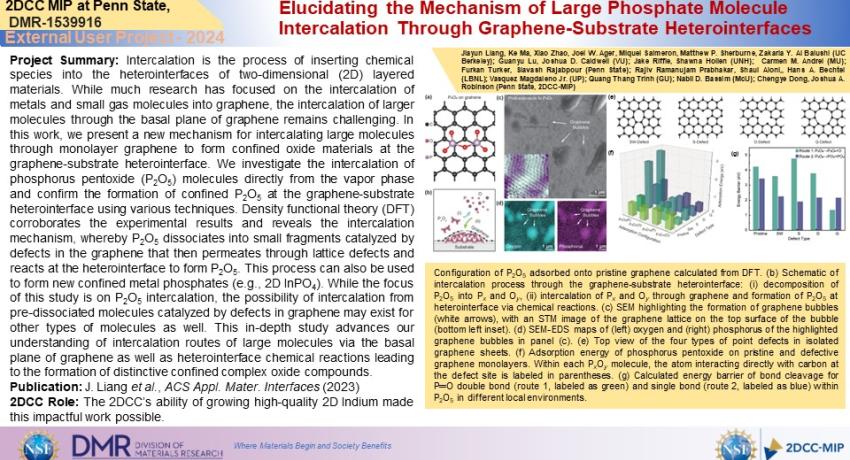Intercalation is the process of inserting chemical species into the heterointerfaces of two-dimensional (2D) layered materials. While much research has focused on the intercalation of metals and small gas molecules into graphene, the intercalation of larger molecules through the basal plane of graphene remains challenging. In this work, we present a new mechanism for intercalating large molecules through monolayer graphene to form confined oxide materials at the graphene-substrate heterointerface. We investigate the intercalation of phosphorus pentoxide (P2O5) molecules directly from the vapor phase and confirm the formation of confined P2O5 at the graphene-substrate heterointerface using various techniques. Density functional theory (DFT) corroborates the experimental results and reveals the intercalation mechanism, whereby P2O5 dissociates into small fragments catalyzed by defects in the graphene that then permeates through lattice defects and reacts at the heterointerface to form P2O5. This process can also be used to form new confined metal phosphates (e.g., 2D InPO4). While the focus of this study is on P2O5 intercalation, the possibility of intercalation from pre-dissociated molecules catalyzed by defects in graphene may exist for other types of molecules as well. This in-depth study advances our understanding of intercalation routes of large molecules via the basal plane of graphene as well as heterointerface chemical reactions leading to the formation of distinctive confined complex oxide compounds.
2DCC Role: The 2DCC’s ability to grow high-quality 2D Indium made this impactful work possible.
What Has Been Achieved: This work provides an insight into the mechanism for intercalating large molecules through monolayer graphene to form confined oxide materials at the graphene-substrate heterointerface. P2O5 can permeate the basal plane of graphene and intercalate into the heterointerface via a two-step mechanism. (i) P2O5 first dissociates into small fragments (i.e., P, O, etc.) catalyzed by point defects in the graphene lattice; (ii) these fragments, once intercalated, can chemically react at the confined graphene−substrate heterointerface forming a condensed phase that chemically resembles the initial state of the molecule. It has been shown that the intercalation of P2O5 at the graphene-substrate heterointerface could effectively tune the doping level of graphene via charge transfer. Moreover, the intercalated P2O5 (and/or its fragments) can also act as reactants and further contribute to other interfacial reactions.
Importance of the Achievement: This work shows the capability to intercalate large molecules, like P2O5, into the EG/SiC interface besides gas molecules and metals with a new two-step mechanism.
Unique Feature(s) of the MIP that Enabled this Achievement: Synthesis of high-quality 2D indium via Confinement Heteroepitaxy (CHet) supplies the opportunity to synthesize new metal compounds, like 2D InPO4.
Publication: Liang, Jiayun, Ke Ma, Xiao Zhao, Guanyu Lu, Jake Riffle, Carmen M. Andrei, Chengye Dong et al. "Elucidating the Mechanism of Large Phosphate Molecule Intercalation Through Graphene-Substrate Heterointerfaces." ACS Applied Materials & Interfaces 15, no. 40 (2023): 47649-47660. https://doi.org/10.1021/acsami.3c07763
Acknowledgments: Z.Y.A. acknowledges the support of this work through the Laboratory Directed Research and Development (LDRD) Program of Lawrence Berkeley National Laboratory under U.S. Department of Energy Contract No. DE-AC02-05CH11231 and the Canadian Institute for Advanced Research (CIFAR) under the Azrieli Global Scholars Program in Quantum Materials. Work at the Molecular Foundry was supported by the Office of Science, Office of Basic Energy Sciences, of the U.S. Department of Energy under Contract No. DE-AC02-05CH11231. Some of the XPS analysis was performed under a collaboration with the Liquid Sunlight Alliance, which is supported by the U.S. Department of Energy, Office of Science, Office of Basic Energy Sciences, Fuels from Sunlight Hub under award number DESC0021266. This research used resources of the Advanced Light Source, which is a DOE Office of Science User Facility under no. DE-AC02-05CH11231. J.D.C. gratefully acknowledges support for this work from the Office of Naval Research grant N00014-22-12035. G. L. is supported through Army Research Office Small Business Technology Transfer (W911NF-22-P-0029). J.A.R, C.D., T.F. and S.R. acknowledge the support of the Air Force Office of Scientific Research (AFOSR) through contract FA9550-19-1-0295 and the 2D Crystal Consortium a National Science Foundation Materials Innovation Platform, under cooperative agreement DMR-1539916. M.P.S. acknowledges the support of the National Supercomputing Centre (NSCC) Singapore via the Project ID 13002533 and the support of the nanoQuench project (CHED PCARI IIID-2016-007). Finally, the authors would thank Dr. Hao Chen for providing In2O3 XPS calibration data for this study.
